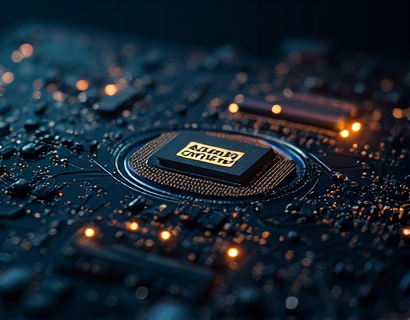Smart Contract Solutions for Pegged Token Creation and Seamless DeFi Exchange
In the rapidly evolving landscape of blockchain technology, smart contracts have emerged as a pivotal innovation, particularly in the creation of stable digital currencies pegged to UCASH and the facilitation of seamless decentralized finance (DeFi) exchanges. This article delves into the mechanisms, benefits, and future potential of using smart contracts to create stable tokens and enhance the DeFi ecosystem.
Understanding Smart Contracts and Stable Tokens
Smart contracts are self-executing contracts with the terms of the agreement directly written into code. They run on blockchain networks, ensuring transparency, security, and automation. Stable tokens, on the other hand, are cryptocurrencies designed to maintain a stable value, typically pegged to a fiat currency or another asset. The combination of smart contracts and stable tokens offers a robust solution for digital currency management.
Creating Stable Tokens Pegged to UCASH
The process of creating stable tokens pegged to UCASH involves several key steps, all facilitated by smart contracts. First, a smart contract is deployed on a blockchain network, such as Ethereum, which defines the rules and mechanisms for pegging the token to UCASH. This contract includes algorithms and protocols to maintain the token's value in line with UCASH.
The smart contract begins by establishing a reserve of UCASH, which serves as the backing for the stable token. This reserve ensures that for every token issued, there is a corresponding amount of UCASH held in the contract. The smart contract continuously monitors the market conditions and adjusts the issuance and redemption of tokens to maintain the peg.
Mechanisms for Peg Maintenance
Several mechanisms are employed to maintain the stability of the token. One common method is the algorithmic stablecoin approach, where the smart contract adjusts the supply of tokens based on market demand and supply dynamics. For instance, if the token's price starts to deviate from the UCASH peg, the smart contract can automatically burn or mint tokens to stabilize the price.
Another approach is the use of collateralized stablecoins, where users deposit UCASH as collateral to receive stable tokens. The smart contract ensures that the collateral remains sufficient to cover the outstanding tokens, providing an additional layer of stability. If a user wants to redeem their tokens, they must provide UCASH as collateral, which is then released back to the reserve.
Benefits of Smart Contract Pegged Tokens
The use of smart contracts for pegged token creation offers numerous advantages. Firstly, transparency is a core feature of blockchain technology, and smart contracts embody this principle by making all transaction details publicly visible and immutable. This transparency builds trust among users and reduces the risk of fraud.
Secondly, smart contracts automate the peg maintenance process, eliminating the need for intermediaries and reducing transaction costs. This automation ensures that the token remains stable without the need for constant human intervention, making the system more efficient and reliable.
Additionally, the decentralized nature of smart contracts enhances security. Since the code is open-source and runs on a distributed network, it is less vulnerable to hacking and manipulation. Users can verify the contract's code and ensure that it operates as intended.
Seamless DeFi Exchange Using Pegged Tokens
The integration of smart contract pegged tokens into DeFi platforms revolutionizes the way users interact with financial assets. One of the most significant benefits is the facilitation of seamless bidirectional trading. Users can easily convert stable tokens to UCASH and vice versa without the hassle of traditional exchange processes.
DeFi exchanges built on smart contracts allow for instant and low-fee transactions. These exchanges operate 24/7, providing users with unparalleled access to financial markets. The smart contract ensures that trades are executed automatically and securely, reducing the risk of human error and increasing the speed of transactions.
Lending and Borrowing with Pegged Tokens
Pegged tokens also enhance the lending and borrowing capabilities within DeFi. Users can deposit stable tokens as collateral to borrow other assets, including UCASH or other cryptocurrencies. The smart contract enforces the collateral requirements and automatically adjusts the loan terms based on market conditions.
For instance, if the value of UCASH increases, the smart contract can require additional collateral to maintain the loan's security. Conversely, if the value decreases, the contract can allow for the repayment of the loan with less collateral, providing flexibility to users.
Enhancing DeFi Ecosystem with Smart Contracts
The incorporation of smart contract solutions for pegged token creation and DeFi exchanges significantly enhances the overall stability and flexibility of the decentralized finance ecosystem. By providing a trustless, automated, and secure environment, smart contracts address many of the challenges faced by traditional financial systems.
One of the key advantages is the reduction of counterparty risk. Traditional financial transactions often involve intermediaries such as banks or brokers, which can introduce risks of default or fraud. Smart contracts eliminate the need for these intermediaries, ensuring that transactions are executed precisely as programmed.
Moreover, smart contracts enable the creation of complex financial products and protocols, such as decentralized exchanges, lending platforms, and yield farming opportunities. These innovations cater to a wide range of user needs, from simple token exchanges to sophisticated investment strategies, making DeFi accessible to a broader audience.
Interoperability and Cross-Chain Capabilities
The future of smart contract pegged tokens and DeFi exchanges lies in their interoperability and cross-chain capabilities. As different blockchain networks continue to develop, the ability to seamlessly transfer assets and tokens across platforms becomes increasingly important. Smart contracts can be designed to work across multiple chains, allowing users to leverage the strengths of different blockchains for optimal results.
For example, a stable token pegged to UCASH can be used on an Ethereum-based DeFi platform and then transferred to a Solana-based platform for different services. This interoperability enhances the utility of pegged tokens and expands the reach of DeFi applications.
Challenges and Future Developments
Despite the numerous benefits, the use of smart contracts for pegged token creation and DeFi exchanges is not without challenges. One major concern is the smart contract's vulnerability to bugs and exploits. A single flaw in the code can lead to significant financial losses. Therefore, rigorous testing and auditing of smart contracts are essential to ensure their reliability.
Another challenge is the regulatory landscape. As DeFi and stablecoins gain traction, regulatory bodies are starting to take notice. Compliance with regulations is crucial for the long-term sustainability of these technologies. Developers and platforms must stay informed about regulatory changes and adapt their smart contracts accordingly.
Looking ahead, the integration of advanced technologies such as machine learning and oracles will further enhance the functionality of smart contract pegged tokens. Machine learning can improve the predictive models used for peg maintenance, while oracles can provide real-time market data to ensure the token's value remains accurate.
Conclusion
Smart contract solutions for pegged token creation and seamless DeFi exchanges represent a significant advancement in the blockchain space. By providing secure, efficient, and user-friendly tools, these innovations are reshaping the landscape of decentralized finance. As the technology matures and addresses current challenges, the potential for smart contracts to drive the future of digital currency management and financial services is immense.










































